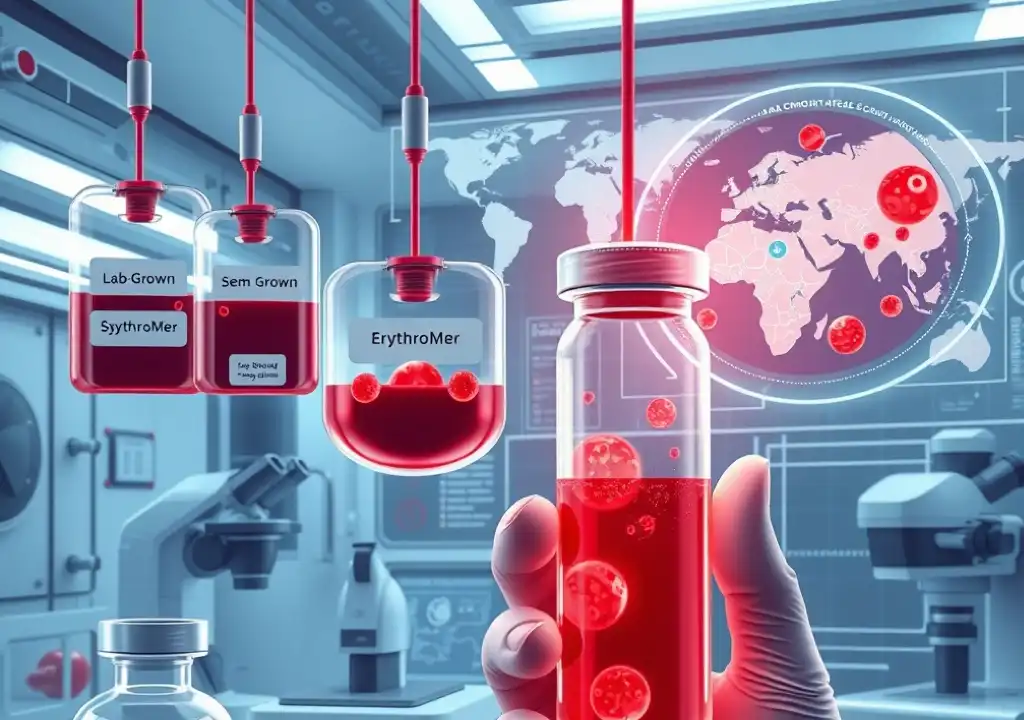Researchers are actively working on the development of artificial blood in response to blood shortages and the need for safer transfusions. Millions of people die globally each year due to inadequate access to blood, as highlighted by the World Health Organization (WHO). Blood plays a crucial role in transporting oxygen throughout the body and removing waste, among its other vital functions. Laboratory-grown blood was first used in human clinical trials in 2022, mainly for patients with rare blood types. Scientists are also developing synthetic blood to support emergency medicine, surgery, and transfusions.
What is artificial blood? Artificial blood refers to both lab-grown and synthetic blood. Synthetic blood, still in research phases, is a fully man-made substitute that doesn’t contain human cells. It mimics the function of blood cells by delivering oxygen, designed for emergency use where matching blood types is difficult. The U.S. military has invested $46 million in developing ErythroMer, a synthetic blood substitute that is universally compatible and stable without refrigeration, though it is still undergoing safety and effectiveness testing. Lab-grown blood, however, involves growing human red blood cells in a controlled environment. Once available, it could improve treatments for various medical conditions, such as providing better platelets to stop bleeding in trauma patients.
How is lab-grown blood made? The process begins with stem cells, which can develop into various types of cells, including red blood cells and platelets. Scientists use haematopoietic stem cells from bone marrow or blood donors. By exposing these stem cells to growth factors in a lab, they gradually transform into red blood cells, functioning similarly to natural ones. Gene editing is also being explored to boost blood production and eliminate blood group markers, enabling universal blood that can be transfused without matching specific blood types.
How close are scientists to producing artificial blood? Lab-grown and synthetic blood products are still in the research phase. In 2022, a clinical trial in the UK used laboratory-grown red blood cells in human volunteers to test their safety and longevity, though more trials are needed before it can be commercially approved. The production cost of lab-grown blood remains high—initially over $90,000 per unit in 2013, now reduced to under $5,000, compared to the $215 cost for donated blood in the U.S. in 2019.
Has artificial blood been used in clinical trials? Yes, artificial blood has been used in clinical trials. A small Japanese study in 2022 tested haemoglobin vesicles, artificial blood components designed to carry oxygen like real red blood cells. The trial involved 12 healthy male volunteers who received various doses of haemoglobin vesicles. Mild side effects like fever and rash were noted but resolved quickly, with no significant changes to vital signs.
How far are we from manufacturing blood commercially? Several hurdles remain for commercially manufacturing artificial blood, including scaling production to meet clinical demand while maintaining safety and efficacy. Regulators such as the U.S. Food and Drug Administration (FDA) are still determining whether lab-grown blood should be classified as cell therapy or medicine, which would influence its regulation.
Can artificial blood be made for rare blood groups? Yes, lab-grown blood can be tailored for rare blood types. Synthetic blood, being cell-free, can carry oxygen without requiring blood group markers, making it a potential universal transfusion option. There are over 600 different antigens on red blood cells, and rare blood types are often defined by missing or unusual antigens. This makes it challenging to find compatible donors, but synthetic and lab-grown blood could address this issue.
Could the creation of artificial blood solve global blood shortages? Artificial blood could significantly alleviate blood shortages, particularly in low- and middle-income countries, where access to blood is limited. WHO reports that 40% of global blood donations come from high-income countries, but these nations make up only 16% of the global population. Severe blood shortages persist in areas like sub-Saharan Africa, South Asia, and Oceania, where mortality rates from hemorrhage are higher. The key advantage of lab-grown blood would be its potential to address crises such as pandemics, wars, and natural disasters, when there is a sudden surge in demand

